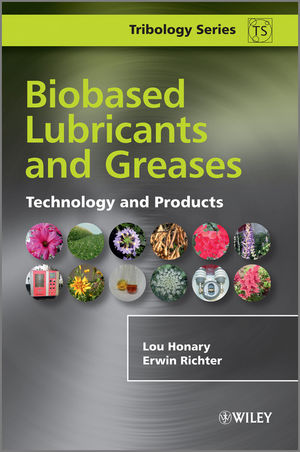Biobased Lubricants and Greases: Technology and ProductsISBN: 978-0-470-74158-0
Hardcover
238 pages
April 2011
 |
||||||
Preface.
Series Preface.
Acknowledgements.
Summary.
Introduction.
1 Historical Development of Vegetable Oil-based Lubricants.
1.1 Introduction.
1.2 Pioneering Industrial Uses of Vegetable Oils.
1.3 Petroleum.
2 Chemistry of Lubricants.
2.1 The Nature of the Carbon Atom.
2.2 Carbon and Hydrocarbons.
2.2.1 Pointers for Non-Chemists on Vegetable oil and General Chemistry.
3 Petroleum-based Lubricants.
3.1 Introduction.
3.2 Basic Chemistry of Crude Oils.
3.2.1 The Paraffinic Oils.
3.2.2 The Naphthenic Oils.
3.2.3 The Aromatic Oils.
4 Plant Oils.
4.1 Chemistry of Vegetable Oils Relating to Lubricants.
4.2 Triglycerides.
4.3 Properties of Vegetable Oils.
4.4 Vegetable Oil Processing.
4.4.1 Degumming.
4.4.2 Bleaching.
4.4.3 Refining.
4.4.4 Deodorizing.
4.4.5 Interesterification.
4.5 Oxidation.
4.5.1 Reducing Oxidation.
4.5.2 Hydrogenation.
4.6 Winterization.
4.7 Chemical Refining.
4.8 Conventional Crop Oils.
4.8.1 Soybean.
4.8.2 Palm Oil.
4.8.3 Rapeseed.
4.8.4 Sunflower Oil.
4.8.5 Corn.
4.8.6 Safflower.
5 Synthetic Based Lubricants: Petroleum-Derived and Vegetable Oil-Derived.
5.1 Esters.
5.2 Esters for Biofuels.
5.3 Complex Esters.
5.4 Estolides.
5.5 Other Chemical Modifications.
5.5.1 Metathesis.
5.5.2 Enzymatic Hydrolysis of Fatty Acids.
6 Genetic Modification and Industrial Crops.
6.1 Introduction.
6.2 Industrial Crops.
6.2.1 Camelina.
6.2.2 Babassu.
6.2.3 Cuphea.
6.2.4 Castor.
6.2.5 Rice Bran.
6.2.6 Jatropha.
6.2.7 Neem.
6.2.8 Karanja (Pongam).
6.2.9 Poppy.
6.2.10 Sesame.
6.2.11 Jojoba.
6.2.12 Coconut.
6.2.13 Lesquerella.
6.2.14 Hemp.
6.2.15 Flaxseed oil.
6.2.16 Safflower.
6.3 Future and Industrial Crops.
7 Biobased Lubricants Technology.
7.1 Determination of Oxidation Stability.
7.1.1 Active Oxygen Method (AOCS Method Cd 12-57).
7.1.2 Peroxide Value (AOCS Method 8b-90).
7.1.3 Oil Stability Instrument (AOCS Method Cd 1 2b-92).
7.1.4 Rancimat.
7.1.5 Viscosity Change as a Measure of Oxidation.
7.2 Applications.
7.3 Petroleum White Oils and Food Grade Lubricants.
8 Performance Properties of Industrial Lubricants.
8.1 Introduction.
8.2 Common Performance Requirements.
8.2.1 Viscosity.
8.2.2 Flash and Fire Points.
8.2.3 Boiling Range.
8.2.4 Volatility.
8.2.5 Cold Temperature Properties.
8.2.6 Density.
8.2.7 Foaming Properties.
8.2.8 Copper Strip Corrosion.
8.2.9 Copper Strip Corrosion Test.
8.2.10 Rust Prevention.
8.2.11 Test Purpose.
8.2.12 Neutralization Number.
8.2.13 Solubility.
8.2.14 Aniline Point.
8.3 Heat Transfer Properties.
8.4 Dielectric Properties.
8.5 Fluid Quality.
8.6 Fluid Compatibility.
8.7 Hydrostatic Stability.
8.8 Demulsibility.
8.9 Oxidation Stability.
8.10 Oxidation Stability for Mineral Oils.
8.10.1 Aromatic Content of Mineral Oils.
8.11 Elemental Analysis.
8.12 Cleanliness.
8.13 Storage and Shipping Temperatures.
8.14 Tribological Performance of Biobased Lubricants.
8.14.1 Four Ball Wear Test: ASTM D 4172.
8.14.2 Four Ball Extreme Pressure Test.
8.14.3 Timken O.K. Load Test – ASTM D 2509.
8.14.4 FZG Rating.
8.15 Metalworking Fluids.
8.16 Biobased Engine Oils.
8.16.1 Stationary Diesel Engines for CORS.
8.16.2 Test Results.
9 Biobased and Petroleum-Based Greases.
9.1 How to Make Soap.
9.2 Basic Process for Manufacturing Grease.
9.2.1 Simple (Soap-Based) Greases.
9.2.2 Complex (Soap–Salt) based Greases.
9.2.3 Non-Soap-Based Greases.
9.2.4 Preformed Soaps.
9.2.5 Preformed Dehydrated Soap for Biobased Greases.
9.2.6 Microparticle Dispersion of Lithium Hydroxide.
9.2.7 Polymer-thickened Greases Using Bio-based Base Oil.
9.3 Continuous Grease Manufacturing Process.
9.4 Use of High Pressure-High, Shear Reaction Chambers (Contactor).
9.5 Vegetable Oil-based Greases.
9.5.1 Alternative Heating Methods.
9.5.2 Heating Method and Impact on Oxidation Stability.
9.6 Grease Consistency.
9.7 Grease Specifications.
9.7.1 ASTM D4950 Specification.
9.7.2 Service Category "L" Chassis (and Universal Joint) Grease.
9.7.3 Service Category "G" Wheel Bearing Grease.
9.7.4 Multi-purpose Category.
9.7.5 Dropping Point.
9.7.6 Water Washout.
9.7.7 Water Spray-Off.
9.7.8 Bearing Oxidation Test.
9.7.9 Grease Cleanliness and Noise.
9.7.10 Grease Mobility Test.
9.7.11 Evaporation.
9.7.12 Oxidation Stability for Storage of Biobased Greases.
9.7.13 Oxidation Stability in Service.
9.8 Friction and Wear Tests.
9.8.1 Four-ball Wear Test and Four-ball EP.
9.9 Application Examples of Biobased Greases.
9.9.1 Rail Curve Greases.
9.9.2 Solid Lubricants.
9.9.3 Truck Greases.
10 Factors Affecting the Environment.
10.1 Biodegradable and Biobased.
10.2 REACH.
10.3 Biodegradation of Oils.
10.3.1 Biodegradability Test.
10.3.2 Electrolytic Respirometer.
10.4 Toxicity Types and Testing Methods.
10.5 Chronic Toxicity.
10.6 Terrestrial Plant Toxicity.
References.
List of Useful Organizations.
Useful Test Methods.
Glossary.
Index.



